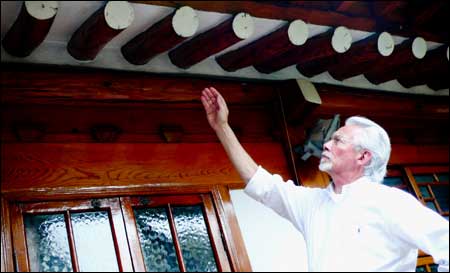Seoul should fight for historical area |
| By Tony MacGregor Korea Times, June 5th 2007 |

.
A visiting urban conservationist from the U.S.
says the there ¡s enough left of Seoul's historic
Gahoe-dong district worth fighting for although he sees cracks in the integrity
of the neighborhood.
Gahoe-dong near Anguk, the last area in Seoul where whole streets of hanok
(traditional Korean houses) are preserved, has been the center of a controversy
as preservationists, led by British expatriate David Kilburn, have clashed
with developers and the city.
David Woodcock, a professor of architecture and director of the Center
for Heritage Conservation at Texas A&M University, said communities
inevitably change and Gahoe-dong has changed in the past.
"Change is as inevitable as death and taxes," he
said. "The question is, how do you manage it for the benefit of the community.
What should we be preserving now for the future?"
Woodcock said some of the new buildings in Gahoe-dong are beautiful works
in themselves.
"The level of craftsmanship and design are outstanding," he
said. "It doesn't surprise me that one of them won an architectural
award. The question is how do they blend in with the rest of the neighborhood?"
He said if the new buildings don't have qualities similar to
their neighbors, it can change the ambiance of the neighborhood in profound
ways and destroy the architectural harmony of the community.
He said it is important that building guidelines be specific enough to
prevent new buildings from infringing on their neighbors and that those
guidelines be adhered to and strictly enforced.
"The first rule in renovation, as in medicine, is "Do no harm," "
he said. "Whatever changes you make, don't harm others."
He said that principle had been accepted in Britain since the Great Fire
of London in the 17th century when people realized that the way they built
their houses affected the rest of the community.
To resolve the conflict over Gahoe-dong, he called for a healthy dialogue* between residents and the city. "People need a clear understanding of
what changes they can accept and what changes threaten the community."
"If wealthy people come into the area and expect to be able to park their
cars near their houses," he said, "it could profoundly
stress the neighborhood, which would require larger streets."
David Kilburn, a leading proponent of conserving Gahoe-dong, said the government¡¯s
efforts to preserve the area have gone terribly wrong.
"There is an enormous gulf between what city officials publicly proclaim
and what they allow to happen in reality," he
said. "Surely, it is time to halt all the destruction of old buildings
in Gahoe-dong, to demolish new buildings with illegal features, and for
society as a whole to consider the fate of the district?
"Is it too much to expect that a country of Korea's economic power should
find the time and the resources to preserve the last couple of short streets
in the city that provide a window into ordinary life a century ago?" he
asked.
More of Kilburn's views can be found on www.kahoidong.com
Tony MacGregor